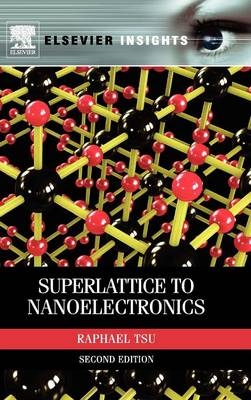
Superlattice to Nanoelectronics
Elsevier / The Lancet (Verlag)
978-0-08-096813-1 (ISBN)
Superlattice to Nanoelectronics, Second Edition, traces the history of the development of superlattices and quantum wells from their origins in 1969. Topics discussed include the birth of the superlattice; resonant tunneling via man-made quantum well states; optical properties and Raman scattering in man-made quantum systems; dielectric function and doping of a superlattice; and quantum step and activation energy. The book also covers semiconductor atomic superlattice; Si quantum dots fabricated from annealing amorphous silicon; capacitance, dielectric constant, and doping quantum dots; porous silicon; and quantum impedance of electrons.
Dr. R. Tsu started his professional career at the Bell Telephone Laboratories, Murray Hill, NJ, 1961, working on the theory and experiments related to electron-phonon interaction in piezoelectric solids. He became a close collaborator of Leo Esaki (Nobel Laureate in 1973) at IBM T.J. Watson Research Center where he joined in 1966, working on theory and experiments of optical- and transport-properties, band structures, in solids, and material characterization. A man-made semiconductor superlattice and modulation doping were conceived jointly with Esaki, in 1969, which led to a rapid development of man-made quantum materials and quantum structures eventually evolved into the present day quantum dots. His original formulation of tunneling through multiple man-made heterojunctions is widely accepted in nearly all aspects of resonant tunneling devices reaching Tera-Hertz, thus far being the fastest device to date. The theory and experiments of man-made superlattices and resonant tunneling through a quantum well led to his outstanding contribution award from IBM Research in 1975 and later in 1985, to sharing the International New Materials Prize of the American Physical Society with Esaki and Chang. In 1979, he became the head of Materials Research at Energy Conversion Devices, Inc., in charge of the study on the formation and structure of amorphous silicon. His major contributions involve the determination of bond angle distribution from Raman scattering and optical absorption measurements and experimental determination of conductivity percolation. In 1985, he became the head of the amorphous silicon research group at the Solar Energy Research Institute (now NREL) as a principal scientist, working on amorphous Si/Ge and Si/C alloys, showing that the famous Tauc's plot may be theoretically derived without adjustable parameters. In 1975, as the recipient of the Alexander von Humboldt award, he took a year sabbatical at Max Planck Institute for Solid State Physics in
1. Superlattice 2. Resonant tunneling via man-made quantum well states 3. Optical properties and raman scattering in man-made quantum systems 4. Dielectric function and doping of a superlattice 5. Quantum step and activation energy 6. Semiconductor atomic superlattice (sas) 7. Si quantum dots 8. Capacitance, dielectric constant and doping quantum dots 9. Porous silicon 10. Some novel devices 11. Quantum impedance of electrons 12. Why super and why nano
| Erscheint lt. Verlag | 22.10.2010 |
|---|---|
| Verlagsort | London |
| Sprache | englisch |
| Maße | 152 x 229 mm |
| Gewicht | 680 g |
| Themenwelt | Technik ► Elektrotechnik / Energietechnik |
| Technik ► Maschinenbau | |
| ISBN-10 | 0-08-096813-9 / 0080968139 |
| ISBN-13 | 978-0-08-096813-1 / 9780080968131 |
| Zustand | Neuware |
| Haben Sie eine Frage zum Produkt? |
aus dem Bereich


